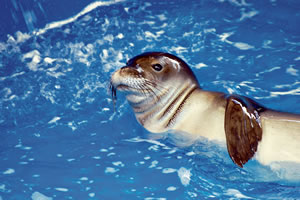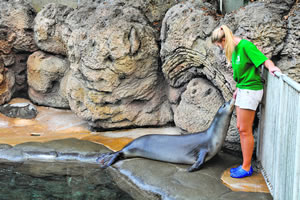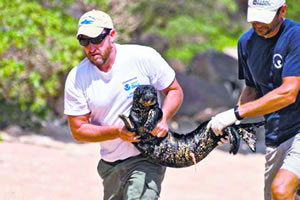At Home In The Islands
Stretching as far back in history as the Hawaiian Islands archipelago itself is the aquatic life that teems at its shores.

By .(JavaScript must be enabled to view this email address)
E-mail this story | Print this page | Archive | RSS

|
Stretching as far back in history as the Hawaiian Islands archipelago itself is the aquatic life that teems at its shores. That ancient symbiotic balance between land and sea has always included the Hawaiian monk seal, until the 1800s, that is when whaling ships arrived seeking fur and oil, and depleted the species that had been thriving in the main chain of Islands.
Though they’ve filtered back down from the Northwestern Hawaiian Islands and are breeding again on our shores, with fewer than 1,100 monk seals in existence, they’re still critically endangered.
“People often aren’t aware that there are seals that are native to Hawaii,” says National Oceanic and Atmospheric Administration (NOAA) Fisheries’ David Schofield, who oversees a network of coordinators and around 500 volunteers who act as the eyes and ears of NOAA’s seal management efforts. “We’ll get tourists calling our response network saying, ‘I see a manatee,’ or they’ll think it’s a California sea lion or a grey seal, but the only ones we have here are the Hawaiian monk seals.
“Even people who live here have a difficult time believing that they’re from here, and it’s understandable because their parents didn’t see them and their grandparents didn’t see them. We have our uphill battle with the recovery of the species, getting people to realize that it’s been here before any of us showed up in the Hawaiian Islands. The main message is coexistence.”
Two attentive, warm, brown eyes and a pair of whiskers are the face of that awareness effort in the form of KP2 (Kauai Pup No. 2), Waikiki Aquarium’s newest inhabitant. Last month, KP2 or Ho’ailona (sign from the sea), the only monk seal ever successfully raised by humans, arrived at the aquarium as an ambassador of his species.
“He’s adjusting well and he’s an absolute magnet for people he’s as interested in you as you are in him,” says aquarium director Dr. Andrew Rossiter. “It’s hard not to get some affinity or affection with this particular animal, so people start reading our information board. He’s doing his job.”

|
The board lists the dangers that face juvenile seals: declining food resources, pupping beaches lost to erosion, sharks, human disturbance, entanglement in marine debris. And it lists some solutions: Become a volunteer, leave monk seals on the beach undisturbed by maintaining a distance of 150 feet, remove debris from beaches.
Ho’ailona’s is a cautionary tale. His journey began when he was born in May of 2008 on Kauai, and was the second pup his mom abandoned. Attempts at handrearing had always ended in futility, so NOAA approached the experts at the Marine Mammal Center in Sausalito, Calif. (marinemammalcenter.org), who rehabilitate hundreds of Mainland seals and sea lions every year. Schofield was on the team that offered round-the-clock care feeding the pup his “salmon oil and squid milkshakes.” After seven months he was healthy and weighed enough to be transferred by the Coast Guard to a shoreline pen at the Marine Corps base in Kaneohe, before being released back into the wild at Kalaupapa.
“Kalaupapa is one of the most important birthing places for monk seals in the main Hawaiian Islands,” notes Schofield. “We met with community members and Hansen’s disease patients, and they welcomed the seal to their peninsula. They felt it was a kindred spirit because the seal had been abandoned and, of course, they have their own story of abandonment.”

|
For a time, Ho’ailona prospered and interacted with other seals, but when he made his way to the less solitary Kaunakakai pier on Molokai and began interacting with humans, NOAA once again had to intervene.
“When he’s small and cute, it’s fun to play with him,”
Rossiter points out, “but when they get up to 400-500 pounds and are 6 or 7 feet long, it’s a completely different prospect.”
“Friendly” adolescent and adult seals, in fact, become a public safety hazard, says Schofield, when they “don’t want you to leave the water and they want to continue playing.” Ho’ailona was retrieved with plans to relocate him to an isolated area of Niihau, but his eyesight was found to be functioning at only 20 percent. He was deemed non-releasable to the wild and sent to the marine facility in Sausalito, where he contributed to research on the species over the past couple of years.
The Hawaiian monk seal is a curiosity because most seals prosper in frigid climes. So, what with this tropical seal that basks in the sun? One point of discovery was that, though huge, monk seals’ metabolism requirements are much lower than other marine mammals meaning they eat much less even than other seal species, consuming only 5 to 8 percent of their body weight per day.
Ho’ailona also helped with another important aspect of research. He was one of the first trial recipients of the morbillivirus vaccine. Every so often, morbilli and other viruses decimate seal populations, and because Hawaii’s seals are isolated and therefore susceptible to germs, if an elephant seal were to swim over from California which has happened and a virus were to spread, it could quickly wipe out the entire population.
Ninety percent of the population lives in the Northwestern Hawaiian Islands, but that population is declining at 4 percent per year, which is unsustainable. The remainder of the seals live on the main islands, and their population is growing by 6 percent each year.
“We’re still not out of the woods,” says Schofield. “The foothold that the species will get, if any, is its ability to survive in the main islands. And that’s why we all have to be careful not to create another KP2. The beach or near-shore waters are our recreational area for surfing or lying on the beach to catch rays, but it’s the monk seals’ bedroom. They’re coming in from a hard day’s work of feeding all night and they’re trying to sleep, so we have to be respectful of that.
“KP2 offers a bittersweet message. Yes, he was the first Hawaiian monk seal to be raised by people, but we don’t want people interacting with seals to the point that they have to be removed from the population and therefore they’re not a functional part of the recovery of the species.”
To learn more, visit waquarium.org, monkseal.ucsc.edu, or look up Ho’ailona at noaa.gov or on Facebook.
Page 1 of 1 pages for this story
E-mail this story | Print this page | Comments (0) | Archive | RSS
Most Recent Comment(s):








